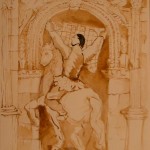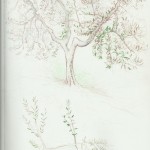Turning and turning in the widening gyre
The falcon cannot hear the falconer;
Things fall apart; the center cannot hold;
Mere anarchy is loosed upon the world,
The blood-dimmed tide is loosed, and everywhere
The ceremony of innocence is drowned;
The best lack all conviction, while the worst
Are full of passionate intensity.
from “The Second Coming” by WB Yeats
Both Chinua Achebe’s Things Fall Apart and Chimamanda Adichie’s Purple Hibiscus make specific reference to Yeats’s oft-quoted and powerful poem, “The Second Coming.” This naturally leads the reader to ask these questions: What exactly is falling apart in the two cultures described by Achebe and Adichie, and why is it that the ‘center cannot hold’? And, most importantly, who are the characters in these authors novels that ‘lack all conviction, while the worst/Are full of passionate intensity’? These are complex questions, but the answers unlock the key to understanding these texts.
Let’s look first at Things Fall Apart and the clash of cultures that leads to the destruction of the Ibo way of life. The main character, Okonkwo represents the plight of tribal life as colonialism takes hold in Nigeria. He is heroic in his fight against the missionaries and wants desperately to preserve the social order of his tribe. However, that is the more ‘global’ conflict of the novel. Okonkwo also is deeply ashamed of his father who he despises for his weakness, and this obsession leads to his destruction.
In Adichie’s Purple Hibiscus, the patriarch Eugene is also deeply troubled by the conflicts in his country. He advocates the return to democracy from military rule through his newspaper, The Standard, and he is devoted to the editor who risks his life to write controversial editorials. Like Okonkwo, however, he refuses to acknowledge his father who adheres to a pagan faith and refuses to let his children visit him. In fact, when Kambili brings a drawing of her grandfather into their home, Eugene beats her within an inch of her life. This hatred, like the one that consumes Okonkwo, becomes his tragic flaw and destroys the entire family.
What is remarkable and important about these novels (and all noteworthy novels, actually) is that they deal with both external (political/religious) forces and internal (family/moral) struggles. They are inextricably linked, for better or for worse, and precisely what makes a piece of fiction universal. The pain that the reader experiences as both cultures and families fall apart is real since we know from personal experience that this is the nature of being human.
And this is why we recommend that your book groups consider reading these novels together (Achebe first, then Adichie). You might also watch Chimamanda Adichie talk about Achebe at http://www.youtube.com/watch?v=41Na23h9-AE Â
Let us know if you decide to pursue this course by posting a comment on www.whatsmartwomenread.com



